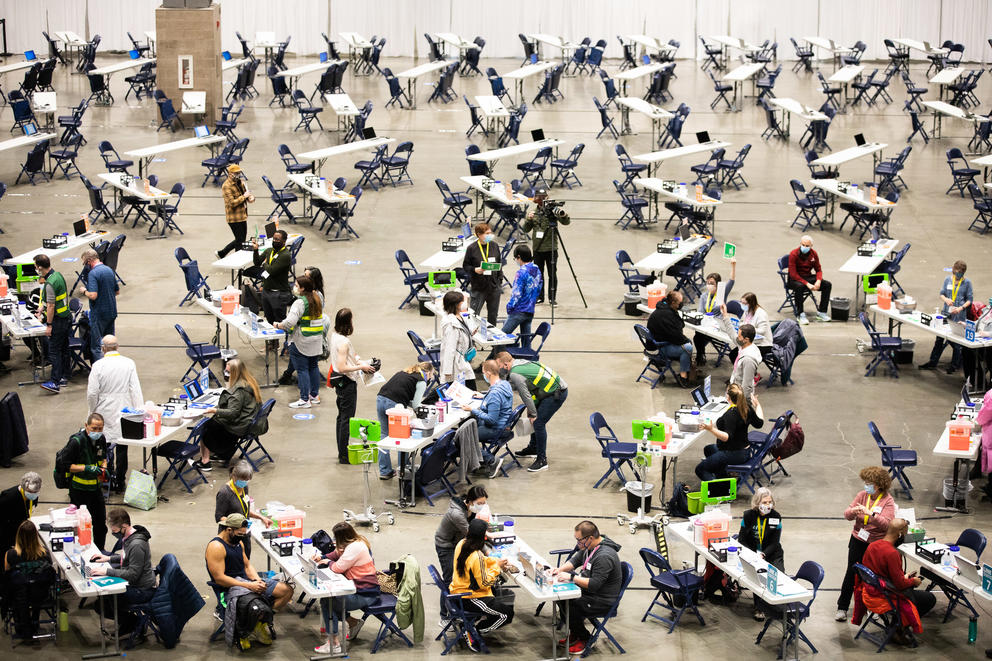“We are absolutely in a better place today than we were a year ago…. We are making meaningful progress,” said Dr. Jeff Duchin, health officer at Public Health — Seattle & King County, in a recent media briefing. “At the same time, we need to be realistic about where we are on this long and winding road to the post-pandemic state.”
In King County, this means that while cases of COVID-19 are going down, they still exceed previous surges, according to data from Public Health. Two years after COVID was first discovered in Washington state, the recent omicron variant surge has led to a fourfold increase in daily cases and doubled daily hospitalizations in comparison with numbers from the peak of the delta variant.
Transmission levels in King County are expected to remain high for weeks — but not quite as high as they were in previous weeks. That translates to more than 4,000 new cases since last week, which was about half the transmission rate from the previous week. Statewide transmission rates are also starting to slow down with a seven-day rolling average of just under 17,000 new cases a day, and an average of 1,528 cases per 100,000 people.
Local and statewide health care systems remain strained, but hospitalizations are starting to level off, with about 300 people hospitalized statewide as of a week ago, 166 of them on ventilators, according to the state Department of Health’s most recent count. While omicron is less likely to land patients in intensive care units, hospitals are still facing a nationwide staffing shortage and provider absences. (For this reason, the state Department of Health is currently discouraging nonurgent emergency-room visits.)
As for questions about whether or when COVID-19 will reach endemic status, Duchin has characterized that changeover as “perhaps an academic distinction with minimal practical implications,” one that would rely on the virus becoming more predictable, which it has not. Duchin said such debates are “of little practical value” and, in fact, could be counterproductive if they encourage behaviors rooted in downplaying the risks of COVID-19.
That hasn’t stopped some from making early predictions. Ali Mokdad, a professor of health metrics sciences at the University of Washington’s Institute for Health Metrics and Evaluation, said the endemic phase may begin as soon as this spring. “After we go back to our normal level of infections, we will have three to four months of very low infections and mortality and hospitalization,” he said.
The IHME has drawn criticism for previous projections, and is unique in declaring the endemic phase so soon, but Mokdad said high infection and vaccination rates had boosted immunity across the population, and could be bolstered by developments like antiviral treatments and variant-specific vaccines. Mokdad said he expected COVID-19 to become a seasonal virus. But even in that scenario, the risk of a surge would remain, he said, citing the 2017-18 flu season, when 52,000 people died and 41 million were admitted to hospitals.
Predictions that specific aren’t widely shared by major public health officials throughout the state. “We’re not out of this pandemic, so we absolutely want to make sure that people are taking every available precaution that they can in order to continue to protect themselves,” said Washington state Secretary of Health Dr. Umair Shah.
As the virus continues to evolve — something viruses do while they’re still in circulation — there’s no way to determine what risks new iterations could present. Future variants could be less virulent than strains like delta, and more transmissible, like omicron.
“But is there a possibility that you could have a variant that is now both transmissible and more lethal or more virulent? Yes, it is possible,” said Shah.
He sees two possible ways out of the pandemic. “One is that we can be transactional — one and done, just as Americans are really good at,” he said. That is: We decide we’re over the pandemic, and move on to “the next headline, the next shiny object.”
The other way out — the “transformational” way — demands more effort over the long term. It means taking into account all of the societal issues the pandemic has unearthed — inequities in health care, the cycle of poverty — and making a real commitment to correcting them. “If we are transformational, then this pandemic is not all for nothing.... The question is going to be where we as Americans and our society, where we're going to land,” Shah said.
But there are reasons to be optimistic. Publc Health’s Duchin said it was reasonable to expect that high vaccination rates, plus recent widespread infection rates, could prevent another major surge, and that these factors, over time, “should lessen the impact of COVID-19 significantly.” But in the meantime, he said, it is important to keep up preventive measures. These include things like getting vaccinated and boosted, limiting indoor and crowded gatherings, making improvements to indoor air quality, using effective face masks, and isolating and testing if symptomatic. To support these interventions, the state has committed to distributing 10 million masks and 3.5 million at-home rapid tests to Washingtonians.
And it’s not clear what that lessened impact will look like. “We're likely never going to go back to where we were prior to the pandemic,” said Shah, but “there will be a new normal and a recognition of the kinds of things that we need to continue to do as we move out of that emergency situation ... into more of an ongoing chronic situation.”
This could mean the eventual loosening of state-level regulations to stem the spread of COVID-19/ “Requirements will become strong recommendations,” he said. “Strong recommendations will become recommendations. Recommendations will become encouragements,”
Still, Shah said, while he was optimistic, it’s important to remain vigilant.
“This pandemic, just as every other emergency I've been involved with, reminds me that the only truth to an emergency is the fact that it is going to be unexpected, that there are going to be a lot of bumps in the road or unexpected turns that are going to occur,” he said. “And if we're not ready to take that on, because we've let our guard down, and said, 'Hey, everything is good, we're fine,' then that's what gets us in trouble.”



